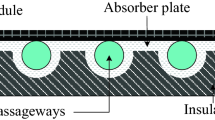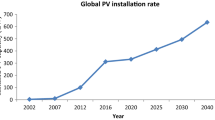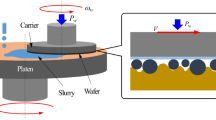Abstract
A material mixing method was suggested to obtain an optimal topology for a multiple material structure with multiple thermal criteria, based on Evolutionary Structural Optimization (ESO). To examine the validity of the method, it was applied to a printed circuit board (PCB) substrate. The overall efficiency of material usage in a PCB substrate was measured in terms of the combination of thermal stress and heat flux density by using a combination strategy with weighting factors. A Pareto optimal topology solution having multiple thermal criteria was obtained. The effects of weighting factors for multiple thermal criteria as well as mechanical boundary conditions on optimal topologies were investigated. It was found that as the weighting factor for heat flux density becomes larger, the sizes of holes at the center portion become larger in order to dissipate thermal energy much more efficiently. It was also found that as the magnitudes of the heat conduction are getting larger, a similar tendency of the optimal topologies is obtained to the above. The thermal stress on the clamped four sides is larger than that on the two sides clamped. It is verified that the suggested material mixing method works very well for topology optimization of a PCB substrate for various mechanical boundary conditions with multiple thermal criteria.
Similar content being viewed by others
References
J. Chae and S. Min, Structural design of piezoelectric microactuator using topology optimization,Trans. KSME. 28 (2) (2004) 206–213.
H. Moon and S. Wang, Topology optimization of displacement input systems, Fall Conference Proceeding of KSME, (2002) 1002–1006.
Q. Li, G. P. Steven, O. M. Querin and Y. M. Querin, Shape and topology design for heat conduction by evolutionary structural optimization,Int. J. of Heat and Mass Transfer, 42 (1999) 3361–3371.
Q. Li, G. P, Steven, O. M. Querin and Y. M. Xie, Optimization of thin shell structures subjected to thermal loading,Struc. Eng. & Mech. 7 (1999) 401–412.
L. Yin and G. K. Ananthasuresh, A novel topology design scheme for the multi-physics problems of electro-thermally actuated compliant micromechanisms,Sensors and Actuators A: Physical 599 (2002) 97–98.
S. Y. Han and S. K. Lee, Development of a material mixing method for topology optimization of multiple material structures,Trans. KSME, 28 (6) (2004) 726–731.
Q. Li, G. P. Steven, O. M. Querin and Y. M. Xie, Structural topology design with multiple thermal criteria,Eng. Comp. 17 (2000) 715–734.
Sigmund and J. Petersson, Numerical instabilities in topology optimization: a survey on procedures dealing with checkerboards, mesh depen-dencies and local minima,Structure Optimization, 16 (1998) 68–75.
Author information
Authors and Affiliations
Corresponding author
Rights and permissions
About this article
Cite this article
Kim, M.S., Kim, S.R., Han, S.Y. et al. Topology optimization of a PCB substrate considering mechanical constraints and heat conductivity. J Mech Sci Technol 21, 2041–2047 (2007). https://doi.org/10.1007/BF03177462
Received:
Revised:
Accepted:
Issue Date:
DOI: https://doi.org/10.1007/BF03177462




